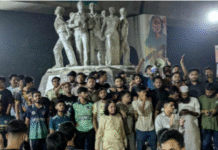A friend of mine has been living in a wealthy European country for the past three decades or so. He often comes to Bangladesh, but hardly ever goes to the village. This time, however, he did. He gave me a call from there: “Bangladesh is supposed to have made strides in development, then why are the people in the villages so poor?”
I replied, “What do you mean? Is anyone starving to death? Don’t they have clothes? Do the village children go around barefoot?”
My friend expressed his astonishment that I should use such indicators to measure poverty, “Is this the way to measure poverty in the 21st century? Does development mean merely being able to eat and not being naked? Is this life?”
My friend is from Netrakona. That is one of the five districts where last April’s excessive rains and sudden landslides destroyed the boro rice crop in the haors or marshlands. Crops on 66,380 hectares of land in the district were wiped out. That was 60 per cent of the district’s cropland. All the crops of Khaliajuri upazila were destroyed.
According to official reports, 168,180 farmers of the district were affected by this calamity which took place five months ago. I called up our district correspondent to find out how the people there were faring, what the children were getting to eat. He said that the poor people of the area were in a bad state. They were struggling to survive, in hunger and need. There was no work. Most of the men were going to the cities in search of employment. Many families had shifted to the city slums. The village schools saw a drastic drop in attendance. Children were going hungry.
My friend who lives in Europe was devastated by the state of the people in rural Netrakona. He couldn’t accept this, this was not life. He felt that is was a cruel farce to say that Bangladesh had made strides in development.
This state of affairs is not in Netrakona alone. I visited Sunamganj in April and saw the distress of the people. The entire boro rice crop of that district had been destroyed. There is only one crop a year in the haors and that was wiped out totally by the excessive rains and deluge of water.
The distress of these people, losing all their crops, seems to be endless. Five months on, they are still at a loss. It will be another month before the water in the marshes subsides and they can sow the next crop. Their sufferings simply pile up. They sought the right to fish in the haors, appealed to the government not to lease out the water bodies. No attention was paid to their appeals. The marshes are not free for them to fish.
Our Sunamganj correspondent told me many male members of the families around the haors have gone to Dhaka and other cities in search of work. Entire families in Sunamganj, like in Netrakona, have shifted to the city slums.
And then came the floods in June and July. The aman rice crop of 33 districts was wiped out. At least 7.5 million people faced all sorts of losses. Of them, about 300,000 lost everything. The government’s relief programme began, but was not well organised. There were allegations of relief being pilfered. Many poor and hungry women told me they received nothing. They cursed those who had deprived them of their rightful relief.
The government declared that no a single person would go hungry. But the government officials did not see how so many people were suffering, hungry. Everything looked good in the books. Tonnes of rice had been distributed. No one cared whether everyone had received an adequate share of the relief.
How are they faring now? How are the blighted people of North Bengal? Our correspondents say the spectre of ‘monga’, the seasonal famine, looms large once again. The people living on the far-flung chars or sand bars are even in a worse state. The government’s relief programmes have ended. The open market sale of rice at low prices is restricted to the cities. The scheme to sell rice at Tk 30 per kg was more necessary in the remote chars and villages.
The children are suffering more. They can’t go to school, they are not getting proper nutrition. They are surviving on boiled rice and salt. Their mothers are in no better condition. Things are bound to get worse in the floods.
The government had promised the flood-affected people that it would remain by their side till the next harvest. It did not keep its word. The non-government relief programmes have also drawn to a close. There is no one by the side of the distressed.
We too have forgotten these ill-fated people. They do not make news any longer. We have now focussed our attention on a different community. For over a month now, the media had simply concentrated on the Rohingya refugee crisis. The atrocities faced by the Rohingyas and their influx into Bangladesh, certainly deserves attention. But that does not mean we should completely forget the huge number of the flood-affected poor people of the haors and North Bengal. They are not news worthy. And unfortunately, the government has completely forgotten its commitment to these distressed hapless people.
Source: Prothom Alo









